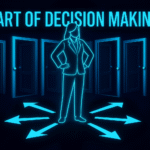Imagine this: you wake up in the middle of the night. Your eyes are open, and you can see your room perfectly, but something is terribly wrong. You try to move, to sit up, to scream but you can’t. Your body is completely frozen, pinned to the bed by an invisible force. A crushing weight presses down on your chest, making it hard to breathe. Then, you see it. A dark figure in the corner of your room, a terrifying presence moving towards you. This is the chilling reality for many who encounter the sleep paralysis demon.
While it feels like a scene from a horror movie, this experience is surprisingly common. Scientific studies estimate that about 7.6% of the general population has gone through it at least once. For centuries, people have shared terrifying sleep paralysis stories, attributing the experience to everything from demons and ghosts to witches and aliens. But what is really happening? Is there a monster in your room, or is the monster inside your own mind?
This article will explore the fascinating bridge between the science of the sleeping brain and the global folklore of the sleep paralysis demon. We will answer the question, “what is sleep paralysis?”, look at its many cultural faces, and, most importantly, discuss how to stop sleep paralysis and reclaim your peace of mind.
What is Sleep Paralysis? The Science Behind the Terror
Before we dive into the spooky stories, let’s understand the science. At its core, sleep paralysis is a natural glitch in your sleep cycle. It’s a moment when your brain wakes up, but your body doesn’t get the message.
Our sleep happens in cycles, and one of the most important stages is REM (Rapid Eye Movement) sleep. This is when we have our most vivid dreams. To protect you from acting out these dreams like trying to fly or fight a dragon in your sleep your brain releases chemicals that cause a temporary muscle paralysis called REM atonia. It’s a brilliant safety feature.
Sleep paralysis occurs when there’s a hiccup in this process. You wake up and become conscious, but the atonia the muscle paralysis lingers for a few seconds or minutes. You are awake and aware, but completely unable to move or speak. It’s a brain-body-disconnect that creates the perfect storm for terror.
Why Does It Feel Like Someone is on Your Chest?
One of the most common and frightening sensations during an episode is a feeling of immense pressure or suffocation. Many people describe it as a demon or an old hag sitting on their chest. The scientific explanation is tied to your breathing.
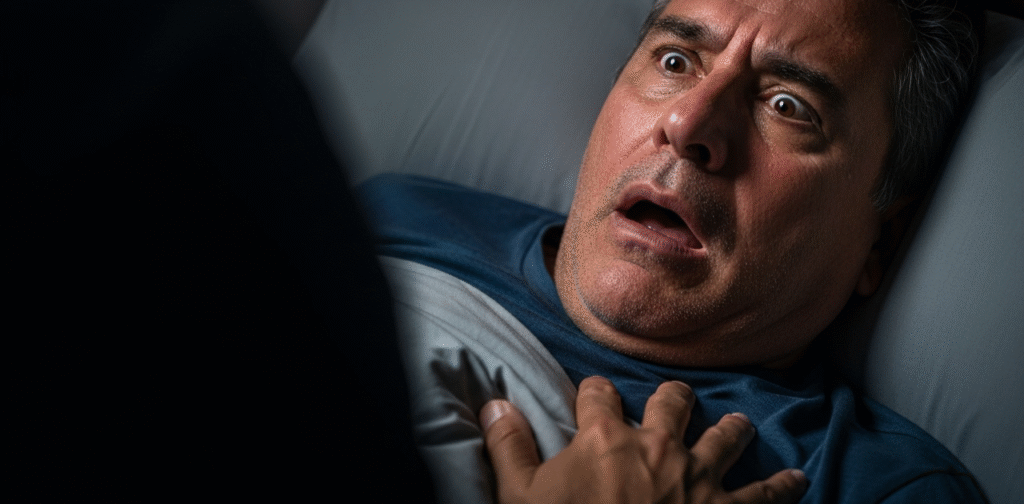
During REM sleep, the only muscles not paralyzed are your eyes and the essential muscles for breathing. However, your breathing becomes shallower and more irregular. When you suddenly wake up in this state, your mind is alert, but your breathing is still in “sleep mode.” This can lead to a slight increase in carbon dioxide in your blood, which the brain interprets as suffocation or pressure. This physical sensation is so powerful that your panicked brain creates a story to explain it: something must be crushing you.
The Hallucinations: Seeing and Hearing Things That Aren’t There
The terror is amplified by vivid hallucinations. This is where the sleep paralysis demon truly comes to life. While you’re trapped and feeling suffocated, your brain goes into hyper-alert mode. It senses a threat (your own paralysis and breathing difficulty) and desperately tries to identify the source. Since there’s no external threat, your mind creates one.
These hallucinations can be:
- Visual: Seeing a dark shadow, an intruder, a monstrous figure, or strange lights in the room.
- Auditory: Hearing footsteps, whispers, screams, humming, or loud buzzing noises.
- Tactile: Feeling a presence touching you, pushing you down, or even pulling you out of bed.
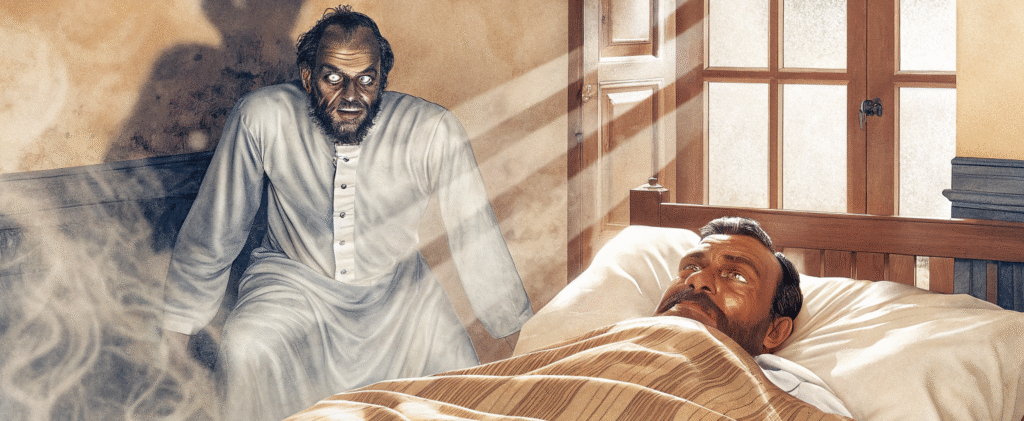
These aren’t just bad dreams; they feel incredibly real because you are technically awake. Your brain is simply filling in the blanks with your deepest fears, which is why so many sleep paralysis stories sound terrifyingly similar.
The Sleep Paralysis Demon: A Monster with Many Names
Long before scientists could explain what is sleep paralysis, cultures around the world created their own explanations. They gave a name and a face to the unseen entity that visited them at night. These tales, passed down through generations, show how the human mind interprets this universal experience through the lens of its own beliefs.
The Crouching Jinn of the Middle East
In Arab and Islamic cultures, sleep paralysis is known as Al-Jathum, which means “the one who crouches.” It’s believed to be a Jinn (a demon-like spirit) that sits on a sleeper’s chest to terrorize and suffocate them. This belief is deeply tied to religious texts, which acknowledge the existence of Jinn.
Interestingly, traditional Islamic thought often allows for both spiritual and physical causes. A visit from the Jathum could be a spiritual attack, but it could also be triggered by physical things like eating too much before bed. To protect themselves, people recite specific verses from the Quran before sleeping, which are believed to act as a spiritual shield. This ancient wisdom provides a way to feel in control, a key element in understanding how to stop sleep paralysis.

Enjoy playing the Wordle game, where you can challenge your mind and language skills by trying to guess the hidden word within a limited number of attempts. Each guess provides you with clues about the correctness and position of the letters, adding excitement and suspense to every round.
The Nightmare and the Old Hag of Europe
Have you ever wondered where the word “nightmare” comes from? It originally described sleep paralysis, not just a bad dream. In Old English, a “mare” was a malevolent goblin or demon believed to sit on people’s chests as they slept, causing horrific dreams and a feeling of being crushed.
This evolved into the terrifying figure of the Old Hag syndrome, a belief particularly strong in places like Newfoundland, Canada. People describe being “hag-ridden,” where an old, withered witch appears in their room and pins them to the bed. The famous 1781 painting, “The Nightmare” by Henry Fuseli, vividly depicts this idea, showing a small imp crouching on a sleeping woman. The Old Hag syndrome is one of the most classic and widespread interpretations of the sleep paralysis demon.
The Pressing Ghosts of East Asia
Across East Asia, the experience is almost universally attributed to ghosts. In China, it’s called Guǐ Yā Shēn “a ghost pressing on the body.” The belief is that a spirit of a deceased person is holding you down. Similarly, in Japan, it’s known as Kanashibari, meaning “bound by metal,” often blamed on angry spirits (Yūrei) who immobilize their victims.
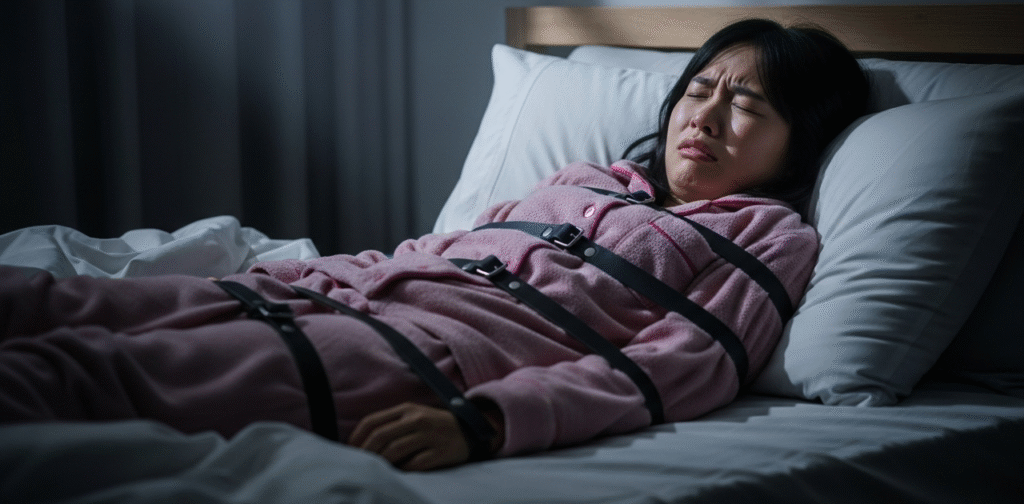
In Thailand, the spirit is called Phi Am, and in Vietnam, it’s Ma Đè (“the ghost that presses down”). These sleep paralysis stories reflect cultures where the boundary between the living and the spirit world is very thin, and ghosts are believed to directly interact with daily life.
From Demons to Aliens: The Modern Monster
So, what does the sleep paralysis demon look like in our modern, tech-focused world? For many, it has taken on a new form: the alien.
Researchers have noted striking similarities between the classic symptoms of sleep paralysis and accounts of alien abduction. Both involve:
- Waking up paralyzed.
- Seeing strange beings in the room.
- A feeling of pressure on the body.
- The sensation of being experimented on.
It’s proposed that the alien abduction phenomenon is a modern interpretation of this ancient experience. Where our ancestors saw demons, goblins, and ghosts, our pop-culture-saturated minds see extraterrestrials. The core terror of being paralyzed and helpless remains the same; only the costume of the “demon” has changed to reflect our modern anxieties.
What Causes Sleep Paralysis and Who Is at Risk?
While the experience can feel supernatural, the triggers are often very down-to-earth. Understanding them is the first step in learning how to stop sleep paralysis.
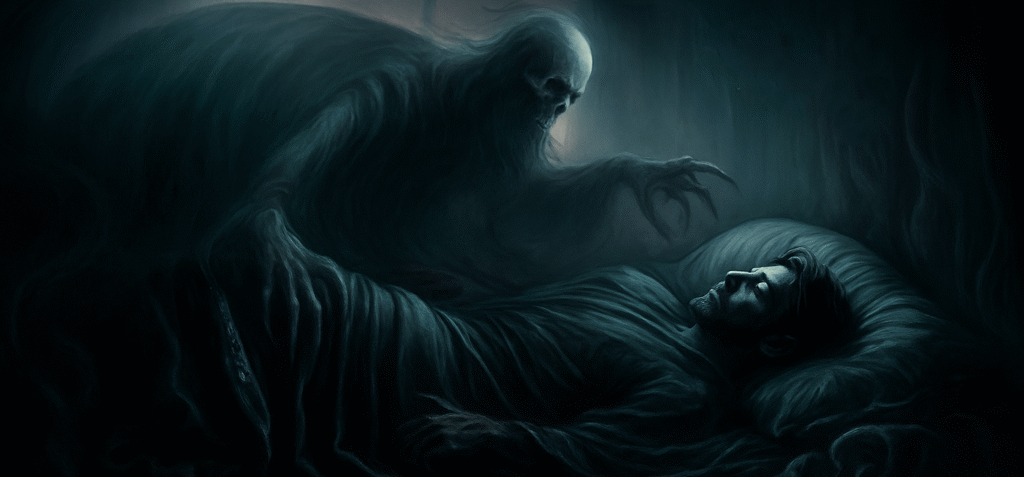
You are more likely to experience sleep paralysis if you:
- Are sleep-deprived: Not getting enough sleep is a major trigger.
- Have an irregular sleep schedule: This is common in students, shift workers, and new parents.
- Are under a lot of stress or anxiety: Your mind’s “fight or flight” system is already on high alert, making you more susceptible.
- Sleep on your back: While it can happen in any position, many report it occurs more often when sleeping supine.
- Have other sleep disorders: Conditions like narcolepsy or sleep apnea are often linked to sleep paralysis.
- Have a family history: There may be a genetic component that makes some people more prone to it.
The link between stress and sleep paralysis is a vicious cycle. Stress can cause an episode, and the terrifying nature of the episode can cause more stress and fear about going to sleep, making future episodes more likely.
How to Stop Sleep Paralysis: Practical Tips and Ancient Wisdom
If you suffer from sleep paralysis, the most important thing to know is that you are not in any real danger, and there are things you can do. The goal is to reduce the frequency of episodes and manage the fear when they do happen.medium.com
Modern Scientific Advice
These strategies focus on improving your overall sleep health and reducing anxiety.
- Prioritize Your Sleep: Aim for 7-9 hours of quality sleep per night. Create a consistent schedule, going to bed and waking up around the same time every day, even on weekends.
- Create a Relaxing Bedtime Routine: Wind down for an hour before bed. Avoid screens (phones, TVs, computers), as the blue light can disrupt sleep. Try reading a book, taking a warm bath, or listening to calming music.
- Manage Your Stress: Practice stress-reducing techniques like meditation, deep breathing exercises, yoga, or journaling. If you struggle with anxiety or trauma, consider speaking with a therapist.
- Check Your Sleep Position: Since many sleep paralysis stories happen while sleeping on the back, try sleeping on your side.
- During an Episode, Try to Wiggle: While your major muscles are paralyzed, some people find they can start to wiggle a finger or a toe. Focusing all your energy on that small movement can sometimes be enough to break the paralysis. Others find that trying to control their breathing or make facial expressions can help.
- Talk to a Doctor: If episodes are frequent, very distressing, or leave you feeling tired during the day, consult a doctor to rule out underlying sleep disorders like narcolepsy or sleep apnea.
Traditional Coping Methods from Around the World
For centuries, people have developed cultural and spiritual methods for dealing with their nocturnal visitors. While not scientifically proven, these methods can provide immense psychological comfort and a sense of control, which is key to overcoming fear.
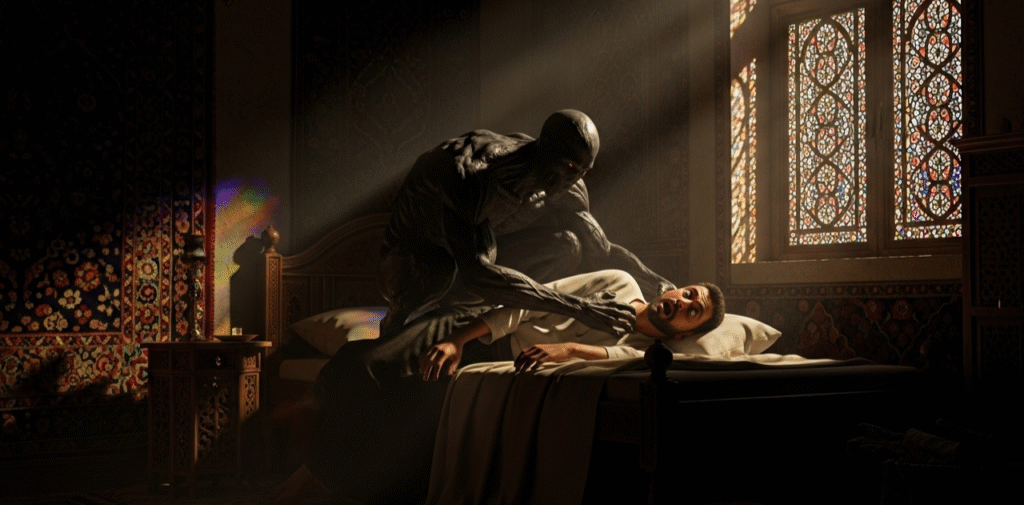
- Spiritual Protection: In Islamic culture, reciting specific Quranic verses is believed to create a protective barrier. In Christian traditions, some people recite the Lord’s Prayer.
- Calling Out for Help: Even if you can’t speak, many cultures believe that trying to call out a specific name (like the name of God or a loved one) can break the spell.
- Changing the Environment: In German folklore, people would place a broom under their pillow or hang horseshoes on their bedpost to ward off the Alp (a nightmare spirit).
- Acknowledging It: The first step is often realizing, “This is sleep paralysis.” Reminding yourself during an episode that it’s a temporary brain glitch and not real can strip the sleep paralysis demon of its power.
You’re Not Alone: A Shared Human Experience
Sleep paralysis is a profound and often terrifying phenomenon. It sits at the crossroads of our biology and our beliefs. The core experience paralysis, pressure, and a perceived presence is a universal part of our human wiring. The difference lies in the story we tell ourselves to explain it.
Whether you see a crouching Jinn, an Old Hag syndrome witch, a pressing ghost, or a modern-day alien, you are experiencing the same brain event that people have been trying to understand for thousands of years. The sleep paralysis demon may wear many masks, but behind each one is a common, and ultimately harmless, quirk of the human brain.
By understanding what is sleep paralysis and learning how to stop sleep paralysis, you can take back control. The knowledge that you are safe and that the experience will pass is your most powerful weapon against the fear of the dark.
Discover the world’s most iconic public squares, where history, culture, and vibrant life come together. Explore breathtaking architecture and lively atmospheres in our top 12 picks. Dive into the heart of global cities visit now and experience these unforgettable urban gems!







